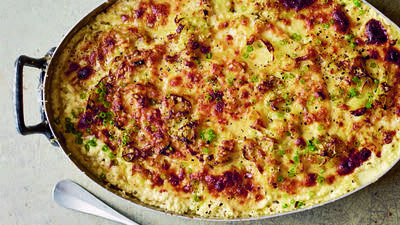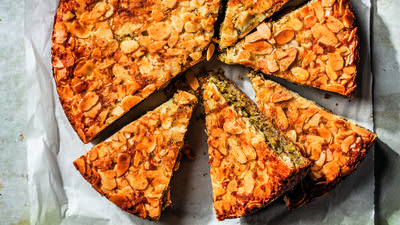
"The more I thought about the things that I was eating that I loved, the more I realized that they all followed these laws," says chef Justin Warner, author of The Laws of Cooking.
He shared his recipes for Foie Gras Doughnut Holes and Better Tomorrow Vegan Chili.
Von Diaz: I've probably had over 100 peanut butter and jelly sandwiches in my life. But to be honest, I've never stopped to think about the chemistry behind it, or even what makes it so delicious. How did you come up with these laws of cooking?
 Justin Warner
Justin Warner
Justin Warner: It started out as reverse engineering things -- understanding why a great dish that I had made sense, and then just stealing compounds of the dish.
Take for example a great pizza from some Neapolitan place. Why does it always work? Why does pizza almost always work? You have something fruity, tomato, you have something rich and fatty, cheese, and then you have something to spread it on.
If you look at peanut butter and jelly, it's the exact same thing. This combination of fat, fruit and something to spread it on is an archetype. It's a law. The reason I call it the law of peanut butter and jelly is because peanut butter and jelly is really the first complex dish that we learn to make as children in America.
The more I thought about the things that I was eating that I loved, the more I realized that they all followed these laws. Then I figured out that the dishes that were head-scratchingly wonderful for me, that really pushed me, followed the law, but then something broke it. I'm addicted to that play.
VD: What are some of those things?
JW: For example, I'll have a foie gras dish at a great restaurant. It will have cacao nib with it, adding a bitter component when generally a foie gras dish will follow the law of peanut butter and jelly (rich foie, fruity something, something to spread it on). By adding a weird, discordant flavor, it becomes very addictive.
VD: Tell me a few of these laws.
JW: The law of peanut butter and jelly, which is about dealing with fruitiness and fats. Then you have the law of coffee, cream and sugar, which is about dealing with bitter things and how they relate to sweetness and fats. Then you have the law of bagel and lox, which is basically about our relationship with smoke. Hot dog, which is with salty and cured foods. The law of the wedge salad, which is about dealing with funky things like blue cheese, lamb or squab. The law of guacamole, which is about understanding fresh fats -- which is my term, but those are plant-based fats. The law of cheese fries, which is really weird, which is about dealing with sharp things, things that can hit you in the back of the nose like a sharp cheese, mustard or wasabi. Then you have the law of lemonade, which is commonly found in fast food, which is our play between sweet and sour. The law of pesto, which deals with herbaceousness. The law of General Tso's chicken, which is about spiciness. Finally the law of gin and tonic, which is about following your nose.
VD: What was the hardest law for you to come up with?
JW: I want to say it was the law of gin and tonic. It required a lot of research on the Internet because these are all based on things that we don't understand. The law of gin and tonic is based on how compounds that we smell are in foods.
For example, pork liver and jasmine -- the aroma is made up of the same compounds. Weird. Did I know that? No. I'm not a perfumeologist and a scientific cook. It was developed by Heston Blumenthal and actually a perfume guy.
For example, the gin and tonic, our noses knew that quinine, juniper and lime all had similar aromatic compounds. Our noses knew that, but we didn't scientifically know that. We were drinking this in malaria times. Wild, right? So that was a tough one to pin down.
 Warner's recipe: Foie Gras Doughnut Holes
Photo: The Laws of Cooking
Warner's recipe: Foie Gras Doughnut Holes
Photo: The Laws of Cooking
VD: One particular recipe that's in this book that you're really known for is the foie gras doughnut. Do you think that people are really going to make foie gras doughnuts in their houses?
JW: I just had someone post -- and it's only because I'm a narcissist and I constantly Google myself. The recipe popped up from a Texan who lives in New York who made the doughnut. But then they stuffed it with cranberry jam, which is not my recipe, to use up extra cranberry sauce from Thanksgiving. I was really excited about it. So yes, people are making this.
VD: What are some of your favorite things that you actually make at home?
JW: I'm really addicted to the not-college ramen broth right now, which is in the law of the hot dog. If you think about ramen, it's basically a liquefied hot dog.
VD: Can you explain the law of the hot dog?
 The Laws of Cooking
The Laws of Cooking
JW: The law of the hot dog is really about salty and cured things. If you think about the saltiness of the ramen broth, then you add pork belly, you add all these condiments to it and then you basically just have noodles swimming around in this. The noodles are just like a hot dog bun, the broth is just like the hot dog, and anything else you want to put on it from here to Chicago, that's ramen.
I also love this really great vegetarian chili recipe that a lot of people are like, "I can't believe there's no meat in this." We use pecans and dehydrated mushrooms. You grind up the mushroom powder. That expands, thickens it and creates all sorts of deep, dark, umami chili flavors.
VD: What do you think these laws teach you about how to cook?
JW: I think they teach you fundamentals that you'll never learn. The fundamentals are actually about our tongues and our interactions with food. I think that when you learn that a lot of really great dishes are based off of simple formulas, you can look through your pantry and say, "I have a sweet thing. It's not what the recipe called for, but I have a sweet thing. I have a rich thing."
Then you learn how to build. In the beginning of the book, I talk about how flavors are like Legos. It's a system. All Legos fit together always. Once you understand how food fits together, which is what this book is about, you're free to jam. You don't need my book any more.
Before you go...
Each week, The Splendid Table brings you stories that expand your world view, inspire you to try something new, and show how food connects us all. We rely on your generous support. For as little as $5 a month, you can have a lasting impact on The Splendid Table. And, when you donate, you’ll join a community of like-minded individuals who love good food, good conversation, and kitchen companionship. Show your love for The Splendid Table with a gift today.
Thank you for your support.
Donate today for as little as $5.00 a month. Your gift only takes a few minutes and has a lasting impact on The Splendid Table and you'll be welcomed into The Splendid Table Co-op.




